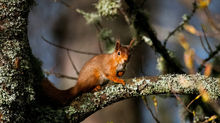What's the Story with Tobermory?
- Andrew Palmer

- Jan 26, 2018
- 5 min read

Well I am not very original with my titles but I am much better at reflecting on my adventures.
This past December my partner and I departed to the Isle of Mull, a last minute decision, to go exploring and have new experiences and no road trip around Scotland is complete without enjoying a dram of whisky (make sure you are not the one driving of course). Little did I expect that this would be the start of my enjoyment of single malt whisky.

So just to give a bit more context I have recently started working as a tour guide at the Scotch Whisky Experience in Edinburgh. Never previously being a fan of whisky and knowing so little about the spirit I initially did not think very highly of it. However, it is impossible not to at least develop an appreciation, if not love..,after learning more about the simple yet subtly varied processes into the art form of making Whisky as well as the rich and colourful heritage and the many regions of Scotland where Scotch is produced. After being at my job for a month or so I thought it would be beneficial to visit an actual distillery.
The Tobermory distillery is the only whisky distillery on the Isle of Mull and opened in 1798 by the British Fisheries Society. The distillery produces two unique style brands of single malt scotch; Tobermory a smooth unpeated and fruity style whisky and Ledaig (pronounced le - chaig) also the previous name of the distillery a more robust and heavily peated whisky. The distillery is being closed for a period of two years for a mass refurbishment but luckily it is still possible to do tours until April 2018 and we were quite fortunate to be the only two people on our tour so it was a very personal and enjoyable experience.
For the purposes of this blog I'll be giving more of personal perspective of my visit rather than the explanation of the whisky making process.

Our guide, a lovely woman from the Isle of Lewis, took us through each of the rooms of the distillery and explained more about the process of whisky making. Working at my job for a month I had a good idea of what was involved in the whisky making process but to see the processing equipment first hand made the pieces of my brain connect together and say
'oh.. that's what happens!'
My first impressions of the equipment of the distillery is that everything was massive! Yes, I had an idea especially for mass production of alcohol the equipment tends to be big but to see it first hand is really quite something.

The Mash Tun looked as if it could fit a small living room inside. The mash tun of Tobermory is a traditional copper dome style and as far as I am aware not often seen in other distilleries today so it was a quite a treat.
The four fermentation chambers or washbacks, again, were really quite something to behold. Ridiculously tall storage containers (roughly 7 metres if I remember correctly...), I could easily imagine someone just going for a swim but it is possibly not the best idea.

The washbacks of Tobermory as with most other distilleries are made from oregon pine. In other distilleries I have heard they have started using stainless steal washbacks as they are much easier to maintain and sterilise but in Tobermory they are very much going to stick to the traditional wooden style as they believe that the wood of the wash backs adds to their unique flavour and character of whisky. It is still debated whether stainless steel affects the final flavouring of whisky, something I am quite keen to learn more about.
The next stage of the whisky process of course is distillation where the alcohol content is strengthened. It is quite fascinating how the science of all of it works. The stills are heated by steam and due to alcohol having a lower boiling point than water the molecules seperate, tiny droplets of alcohol defy gravity make their way up the these very tall stills and then condense all the way down into the spirit safe. I was certainly impressed getting to see these stills in person let alone photograph them. Another fun fact about the spirit stills, instead of disassembling them the stills must be fully built before being put into place, so the entire roof of the distillation room will have to be removed and the stills carefully placed into position.It is certainly no mean feet and a sight I would be most impressed to see.

When I was first told about the process of a spirit safe the whole concept went over my head, so seeing one first hand certainly helped me to get to grips. Basically a person remains on duty (normally the taxman who if I remember correctly lived on site) and separates the distilled spirit into two compartments by manually pulling a lever depending on the quality of spirit. Basically the first and last parts of alcohol tend to be the ones with the more impure compounds and they are put into back into the stills for distillation and the heart of the spirit is the the part with the purist alcohol will be going straight to maturation.

Making our way back outside and across the courtyard we entered the whisky bedroom which we were warned to be quiet because the whisky was sleeping.. no... seriously there is sign that says 'shhh the whisky is sleeping'.
Both the Tobermory and Ledaig whiskies are matured for a minimum of 10 years and there is also a 20 year addition both ex bourbon casks and Sherry casks are used for the maturation with a 50 year edition to be released around 2020. With the 50 year Tobermory I was enlightened to the full extend of the 'Angel's Share' and why older whiskies are more expensive. The sherry cask where the liquid was being matured was nearly 80% empty all due to evaporation (or very happy angels). Due to having a lower amount of liquid in the cask and due to heavy taxation on whisky it is no wonder that 50 year edition of any whisky is over a few thousands pounds. I'll have to get saving for that one.

For the grand finale we (well I) got to have a little dram of tobermory and lediag, personally I found the Tobermory more enjoyable with a smooth finish, hints of berries and citrus fruits, more my style, whereas the Ledaig I felt tasted like smoked cheese. But that's the beauty of whisky tasting every pallate is unique so no dram will taste the same to another individual which I think is pretty cool.

Now even if you are not a big whisky fan the Isle of Mull has so much to offer. It is one of the larger islands of the Hebrides with a mix of rugged coast, surrounded by mountains that rival the Cairngorms intertwined with fresh and salt water Lochs . The Isle is a haven for wildlife as well, whether you are big birdwatcher or want to see something a little rarer, The shores of Loch Ba are an excellent place to see otters, the island is a stronghold for white tailed sea eagles the largest bird in the UK as well as some of the last pure red deer that have not hybridised with the introduced sika deer. Boat trips to the island of Iona, many castles, beaches and so much more!
I will definitely be back to Mull and (hopefully) actually buy a bottle of Tobermory to savour at home, it is definitley my one regret. But there are still many more distilleries and beautiful areas of Scotland to see.

if you want to know more about the Tobermory whisky making process please visit their website or book a trip to mull and visit the distillery it is well worth a visit.
http://tobermorydistillery.com/
If you would like to see more of my adventures around Scotland please follow my Instagram
@palmera93_photography
https://www.instagram.com/?hl=en

















Comments